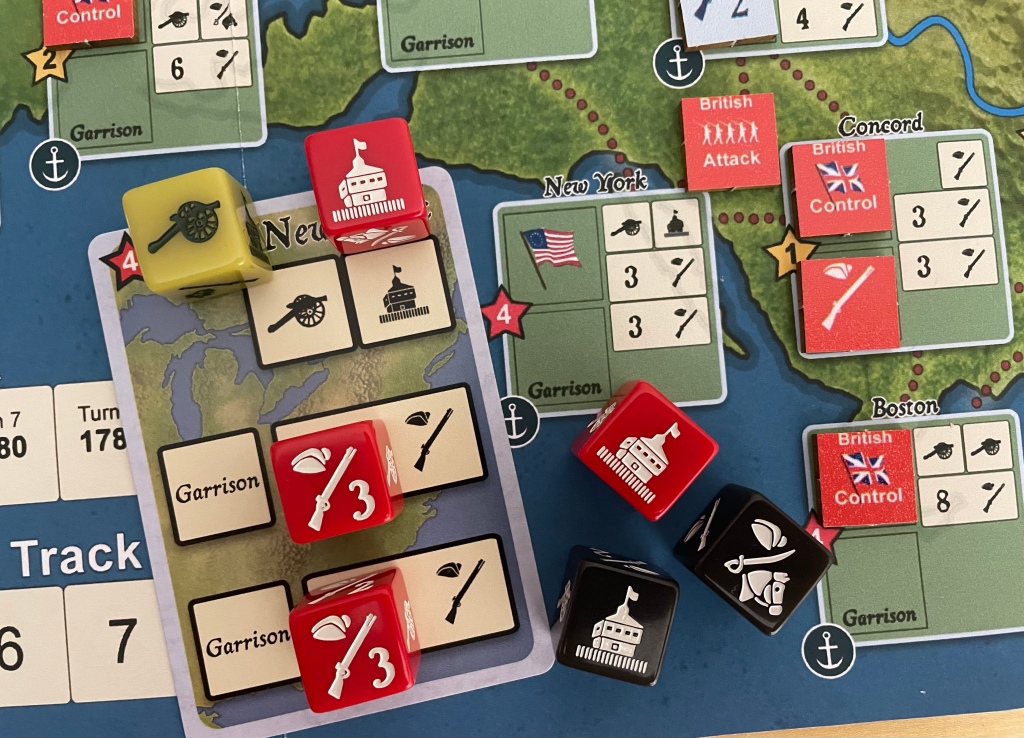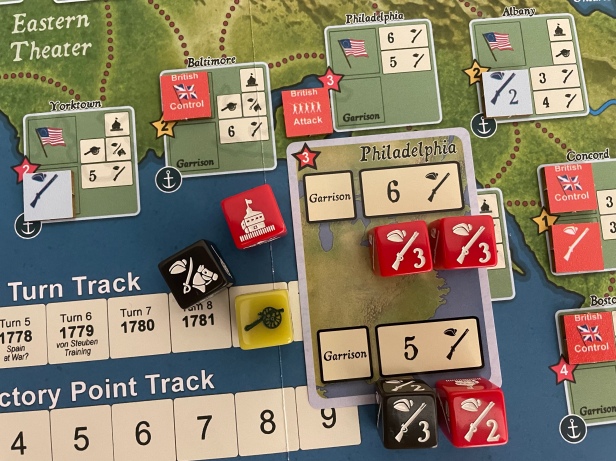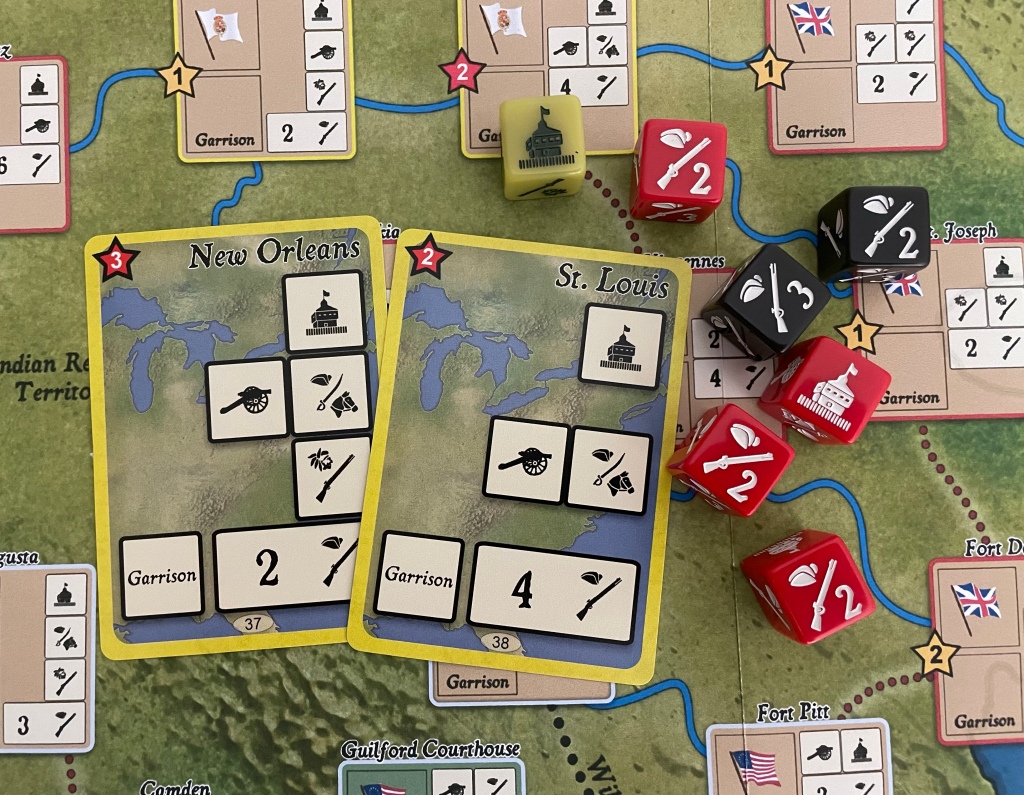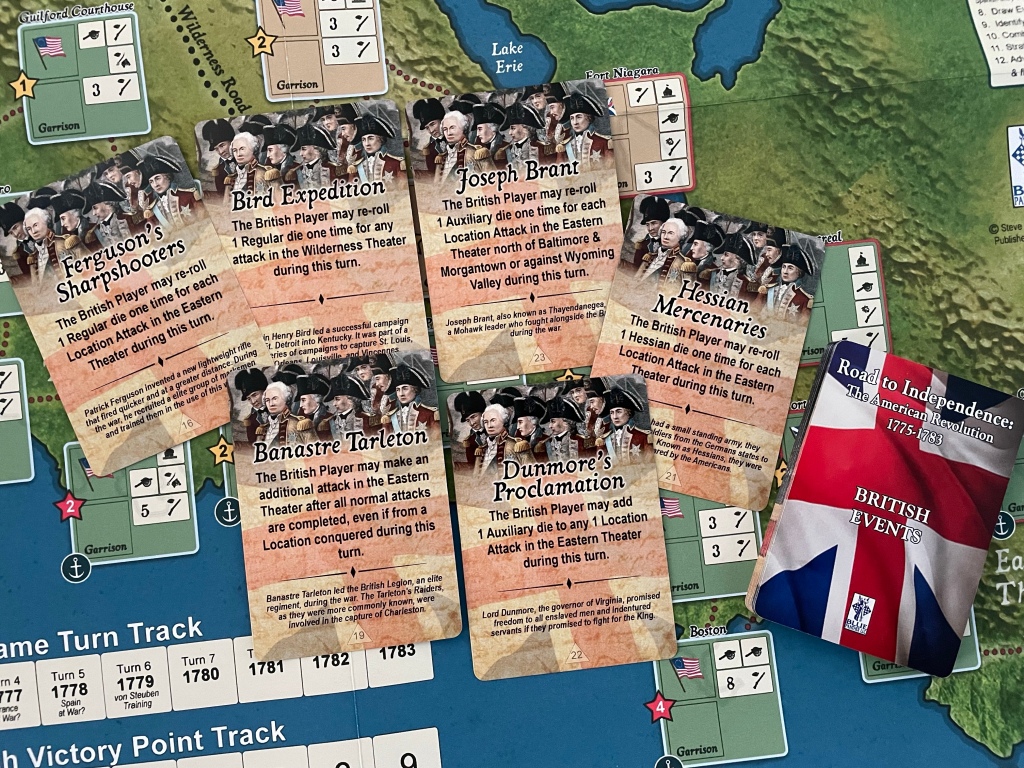Not every wargame has to be deep. Some of them are light and fast playing and are just fun and interesting to experience. But, with this lightness, that doesn’t mean that the game isn’t a good representation of the history or an interesting play experience. Such is the case with a new game called Road to Independence: The American Revolution, 1775-1783 from Blue Panther.
Road to Independence: The American Revolution, 1775-1783 is the second in a planned series of games that will simulate various important conflicts in American history in a casual format. The first game was called French & Indian War from The Historical Game Company and the third game will cover the American Civil War. In this game, two players clash and take the sides of the British or the Americans fighting over the control of the Thirteen Colonies. One of the interesting things about the game is that it not only includes the Eastern seaboard but also the conflict in the far Western territory, a theater not often covered in games on this conflict. Both players will fight for control of important locations using specially made dice that represent British and American regulars, Native American allies, militia units, and (for the Americans) French and Spanish forces. Each player also has their own deck of Event Cards that will allow special events and actions to occur, ensuring that no two games will play the same.
In Action Point 1, we looked over the Game Board and discussed the two theaters depicted including the Wilderness Theater and the Eastern Theater and their differences. In Action Point 2, we took a look at the Location Cards and their use. In Action Point 3, we discussed the various different custom dice and what units they represent and how they are used in the game. In Action Point 4, we looked at the Event Cards and their effects. In this Action Point, which is the conclusion to this series, we will discuss the victory conditions and examine which side has the trickier time of achieving theirs.
Victory Conditions
The objective of Road to Independence is for each player to capture and control their opponent’s Locations while simultaneously holding onto their own Locations. This statement is somewhat misleading though as the onus is really only on the British player to have to capture Locations to win the game. If the American player prevents the British player from capturing enough Locations to reach 30 Victory Points AND the British player doesn’t control at least 4 of the 7 Key Locations including Boston, Charleston, New Orleans, New York, Philadelphia, St. Louis and Yorktown, the game will end in an American victory. The British player starts the game with a total of 25 Victory Points but holds not a single one of the Key Locations. These Key Locations are identified on the Board with a red star icon.

This means that the British need to go out and conquer at least 4 of these Key Locations, which is not as easily done as it is said. If you look at the picture above, the 5 Key Locations located on the Eastern Seaboard are shown including Charleston, Yorktown, New York, Philadelphia and Boston. The 2 Key Locations not shown are located in the Wilderness Theater and include New Orleans and St. Louis. None of these Key Locations are easy to take as they typically require at least 2-3 different type of forces to conquer and in the case of Boston, New York and Philadelphia require significant Infantry to be able to defeat the Location Defenses utilizing multiple dice, probably 2-3 dice, to fulfill the requirement.
Boston is the toughest nut to crack as it have 3 different Defense boxes and requires 5 dice at a minimum to meet the requirements to defeat those Defenses. This estimate of 5 is probably truthfully more like 6 at a minimum as you cannot count on rolling 8 required Infantry on the 7 dice that can be used by the British. This is where having an Event Card that allows a reroll is advantageous and should be kept in mind before this Location is attempted.

Next, taking a look at the meatgrinder that is New York, we see that it requires less Infantry with a total of 6 spread out over 2 different Defense boxes, along with a Cannon and a Fort. I think that the minimum dice here to be able to accomplish this task is 4 but more than likely 5-6 dice. This Location is definitely the 2nd easiest of the Key Locations on the Eastern Seaboard with Charleston being the easiest.

Philadelphia is a bit easier than say Boston but not by much. It requires a total of 11 Infantry spread out over 2 different Defense boxes which means you will need at a minimum 4 dice to accomplish this attack but as stated before more likely needing 5-6. You just cannot guarantee rolling enough 2 and 3 value Infantry to fill these boxes and will most likely lose a few dice due to rolling multiple Cavalry, Forts or Cannon.

Finally, you can look at trying to Attack out in the Wilderness Theater and taking out New Orleans or St. Louis but neither of these are guaranteed either. New Orleans and St. Louis seem to be two of the most difficult to take for the British as they each require at least 5 total dice out of 7 to defeat. I feel like the British player needs to keep their attention in the Eastern Theater.

One final comment that I have was already stated in Action Point 4 where we took a look at the Event Cards. If you remember, the Event Card Surprise Attack is a very powerful card for the American player. The effect of the Event allows the American player to simply place a Control Marker and remove any British Garrison Counter from any Location in the Wilderness Theater. The one requirement is that the Location targeted must be connected to an American Location. Remember, that a connection can be via a River or a Trail/Road.

This is a very powerful card because it takes a Location from the British and doesn’t count against the 3 Attack limit per turn so the American player can Attack 3 additional Locations and make a huge dent in the British Victory Points. This is the only Event Card like this in the game and the British have nothing quite like it. This could potentially be used to recapture a recently taken New Orleans or St. Louis Key Location and wouldn’t that just suck?
There are also several really negative effect Event Cards that go against the British. Negative effect cards that take away Attacks or cause the loss of a die are particularly difficult for the British as they are the side that has to be aggressive and take their victory. Remember that each player is allowed 3 Attacks per turn and losing one or two of these can be very bad.

For these reasons, I think that the British is the side that will have the most difficult time in winning the game. They have to attack every turn and as they have to take 4 of the 7 Key Locations, which are extremely difficult to defeat, they will find that their attacks will not always be successful and this will cause them difficulty. Starting at 25 Victory Points and needing to get to 30 by the end of Turn 10 is doable but it requires that things go the way of the British. A cagey American player, through the deft use of their Garrison Counters and proper use of their Event Cards can prevent British victory in defending Locations but also in striking back and retaking Locations.
We have not played the game a glut of times but in our few plays we have seen a pattern emerge in American victories. In fact, in all 3 of our plays the Americans won. Each of the games was close but it is such a difficult climb for the British. This doesn’t diminish the playability of the game and I suggest that this is a game that you should plan to play each side in a given night and compare the overall score of the British in both to determine the real victor.
In case you are interested, we also posted an interview with the designer Steven Kling and you can read that at the following link: https://theplayersaid.com/2023/09/18/interview-with-stephen-l-kling-jr-designer-of-road-to-independence-the-american-revolution-1775-1783-from-blue-panther/
If you are interested in Road to Independence: The American Revolution, 1775-1783, you can order a copy for $60.00 from the Blue Panther website at the following link.
-Grant

Very nice review, all of Mr. Kling games are awesome and fully Goober approved.
LikeLiked by 1 person
Interesting that the American won all 3 of your games. When we did some playtesting with both teenagers and adults it was about 2 out of 3 for an American victory. In a couple cases where a younger player was playing an older one, we dropped the required British victory point total by a couple of points to even up the competition. You could of course do that but there are some stategies for the British to win but as you point out, it is more important for them to capitalize on the card play and to try to do that more in the first half of the game than the second. Anyway, my two cents.
LikeLiked by 1 person
It still is a great game and I think when we finally break through with a British victory it’ll be that much sweeter. I just think the cards are pretty leaning towards the Americans and taking away attacks on a few really make it hard for the Brits. Great game though as I said.
LikeLike
You are right. The cards do intentionally favor the Americans. I use a fair amount of math analysis in my games and the card bent was needed in part to offset the dice advantages the British have until the Von Steuben/French entry kick in and to prevent the British rolling up the all the coastal locations. And of course, to tilt the game historically some towards the Americans.
LikeLiked by 1 person